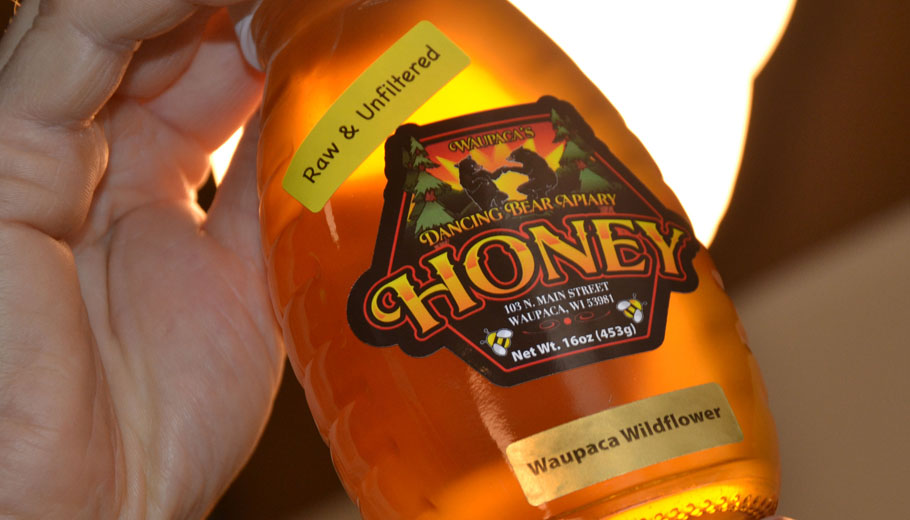
Local honey ranked world class
By James Card
Kent Pegorsch recently won an award that is the equivalent of the Super Bowl of beekeeping.
Pergorsch is the owner of Dancing Bear Apiary. Hhe submitted his Waupaca Wildflower honey to the Black Jar Honey Tasting Contest organized by the Center for Honeybee Research.
The goal of the contest is to identify the best tasting honey in the world. The contest is named “Black Jar” because all of the honey jars are shrouded in a coded black bag so the judges only focus on taste and not color or clarity.
Each year 500 to 1,000 entries are submitted. Out of those, the judges picked 12 winners and the Waupaca honey was among them.
Other winning honeys came from Spain, South Carolina, Hungary, Alaska, Uruguay, Vermont, Netherlands, Kansas and two from Slovakia. The honey from Spain took the grand prize.
The Waupaca honey Pergorsch submitted won in the Medium Amber category. He entered for the first time the year before and he missed being in final 30 entries.
On Sunday, June 4, Pergorsch was working in his bee yard when he heard the news. Stephanie Slater, a fellow Wisconsin beekeeper and friend, was at the completion and called him.
“I just wanted to be the first to congratulate you that you’re in the finals,” Slater said. Then his cell phone reception cut out. He refreshed his phone over and over again.
Pergorsch was working with his son and they discovered the event was being live streamed online except there was no sound as the winners were being announced.
“It was a very intense day. They later confirmed it on Tuesday. I was a little hard to get along with for two days,” said Pergorsch. “This validates that I do know my honey is a really good tasting honey when competing against honeys from all over the world. That’s the most important thing that I get out of this contest and I will definitely be competing in future years,” he said.

From local flowers
“Our honey in Waupaca almost always comes in this color which is the most common color because there are so many floral sources coming into it. Usually lighter honeys are when they have one floral source, it’s very light. But that’s part of the beauty of our honey here is that there is so many different floral sources that are all melding together. Every year the flavor is a little bit different. Like last year, black locust was a phenomenal bloom. I never seen something like that in my 40-some years so I don’t know if I’ll ever have that particular taste of honey again,” said Pergorsch.
The honey that won was from last year’s harvest and a mix of the area’s blooms: black locust, basswood, spotted knapweed, purple loosestrife, white clover and sweet yellow clover. The honey of black locust – also called acacia – is highly prized around the world and black locust is found throughout the forests of Waupaca County. Black locust, spotted knapweed and purple loosestrife are listed as invasive species in Wisconsin and oddly enough, Pergorsch is capturing something of value from species that are deemed undesirable.
Pergorsch uses the French concept of terrior that means “a sense of place” and is used to describe the environmental factors that affect a crop’s uniqueness. It is why wine from Napa Valley is distinct from wine in Normandy.
“We’re gaining notoriety for our good honey here in this part of the Midwest and in Waupaca for my honey. It’s because everything comes together to make this great tasting product,” Pegorsch said.
“Western Michigan through eastern Minnesota, that swath seems to produce some good-tasting honeys. Honey that people like. I believe it’s the soil and the climate here that gives us a really good-tasting honey,” said Pergorsch. He also cites Waupaca’s mixed landscape of fields and forest as good place for bees. He recently got permission to place hives in a sweet clover field hidden away in the woods.
Not all local native blooms are beneficial. “Goldenrod honey stinks. It smells like wet feet – terrible. It doesn’t taste bad after it’s been in the pail for a while but you walk into somebody’s honey house when they are extracting goldenrod honey and you think, what smells like dirty socks in here?” said Pergorsch.
To avoid the wet-sock taste, he pulls his hives by Aug. 15, before the late-summer goldenrod bloom.
Help the bees
His last best year was in 2017.
“Years ago we used to get 100 to 150 pounds per hive of honey. Now the average is 60 pounds per hive. In 2017 it was a 120 pound average, said Pergorsch.
Part of the decline in harvest is directly related to clean farming practices that have taken over wildflower habitat and the advent of the Varroa mite – a pest so dangerous that in a human comparison, it would be like having a wood tick the size of a baseball attached to one’s body. The mite shortens the life of the bees and the last week of a bee’s life is its most productive. One week the hive is healthy, the next week they are dead.
Dave Hackenburg, a friend of Pergorsch in Pennsylvania, coined the term “colony collapse disorder” and is credited to bringing more public awareness to this phenomenon.
The award-winning honey and other varietals can be found at Main Street Marketplace in downtown Waupaca. To help out local bees, Pergorsch suggests to plant pollinator-friendly seed mixes (butterflies that arrive are a bonus) and to recognize No-Mow May.
In the month of May, give the lawnmower a rest and let the dandelions bloom which provides a food source during a nectar-gathering shoulder season.
To learn more about planting bee habit, Pergorsch recommends the University of Minnesota’s Bee Lab at beelab.umn.edu as a top source for useful information.
